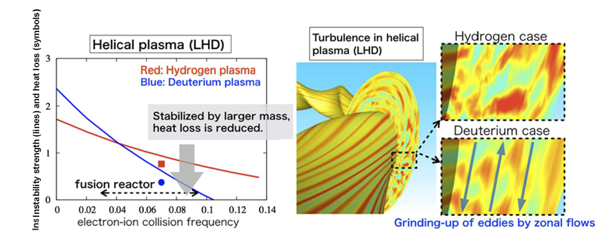HOME > Research Activities > Research Updates >
Physical Mechanisms Solved by Supercomputers
In achieving the generation of fusion energy, it is necessary to confine plasma over a long duration and to maintain the high-temperature condition that exceeds one hundred million degrees. Throughout the world, research institutes are conducting studies in plasma confinement. In the Large Helical Device (LHD) at the National Institute for Fusion Science, seeking still further performance enhancement, experiments using deuterium have begun. In the many plasma experiments that have been performed abroad and in Japan, by using deuterium ions, which bear twice the mass of hydrogen ions, the loss of energy from plasmas has fallen, and the phenomenon of plasma performance improvement called the “ion mass effect” has been observed. However, how is the increase of ion mass linked to the enhancement of performance? The details of the physical mechanism are not understood. In plasma physics research and fusion research over the past quarter century and longer, this is an issue that has not yet been solved.
In research to date, the most important cause of heat loss is now understood to be “turbulence” generated inside the plasma. “Turbulence” is irregular waves and eddies, and the phenomenon of plasma turbulence is extremely complicated. In plasma confined by the magnetic field, a large quantity of heat may be carried out of the plasma by turbulence, and heat loss occurs. On the other hand, under certain conditions are formed “zonal flows,” in which characteristic flows are formed spontaneously. The zonal flow has the effect of dividing eddies and controlling turbulence by forming stripe-like flows simultaneously which flow in the opposite directions each other. Moreover, inside the plasma numerous electrons and ions are in motion. Those fly about and occasionally collide. Those collisions suppress the instabilities that are sources of turbulence (the growth of turbulence). In this way, because various physical mechanisms are involved complexly, simulation analysis through supercomputers for clarifying the plasma turbulence phenomena is needed (for details please refer to the back number 268).
At the National Institute for Fusion Science we are advancing with simulation research on the ion mass effect, which will be the key for improving the performance of deuterium plasma, focusing on turbulence and the zonal flow. In particular, systematic simulations regarding turbulence of hydrogen and deuterium plasma in LHD and tokamak devices have been problematic until now, because immense calculation capacity is required. At NIFS, using the cutting edge supercomputer called “Plasma Simulator” and the supercomputer “Kei” at RIKEN Advanced Institute for Computational Science, we have succeeded in performing simulations. As a result of this, we have investigated in detail how the instabilities (growth of turbulence) caused by the electrons moving along the magnetic field lines which are called trapped electrons, and the turbulence and the zonal flow which develop from the instabilities are affected by the ion mass composed of plasma.
Based upon systematic simulations using hydrogen plasma and deuterium plasma, when the plasma density was high and the collision frequency between electrons and ions was high, we discovered that the influence of the ion mass became more remarkable, instabilities in deuterium plasma were suppressed and turbulence weakened, and heat loss decreased. Further, we also clarified that in a deuterium plasma which received the influence of this ion mass the zonal flow, too, became stronger, effectively ground large eddies and waves, and was suppressing the turbulence further.
We also discovered the existence of common features in these physical mechanisms for helical and tokamak plasmas. We were able to clarify completely this ion mass effect that had been a long-standing unsolved problem and ascertain one of important mechanisms that holds the key for the high performativity of plasma. At present, we are cooperating with the LHD deuterium plasma experiment, and continuing our verifications.

(left)
Simulation results which indicate that the increase in collision frequency brings about the decrease in the trapped electron instability. As collision frequency increases in a higher density plasma, the strength of instabilities in deuterium plasma (blue) weaken more rapidly than in hydrogen plasma (red). The symbols (dot and square) and dashed lines indicate, respectively, the quantity of heat losses and the collisionality regime which is relevant to the fusion reactors.
(right)
Turbulence in LHD plasma. In the red color area, strong eddies and waves are generated. In a deuterium plasma with large ion mass, the zonal flows (blue lines) are formed more significantly and they are grinding eddies and waves into small sizes and suppressing turbulence.
